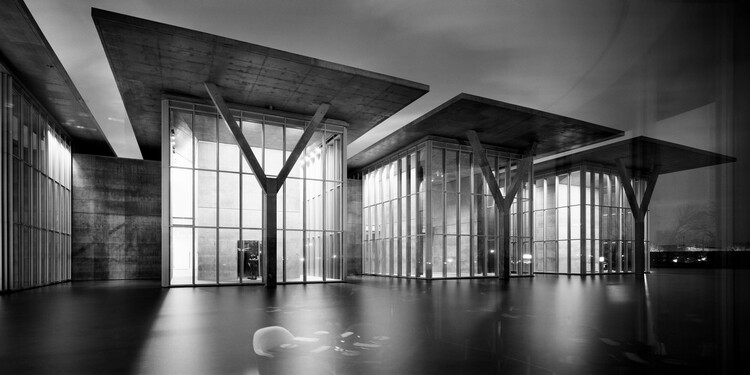
Few other materials can convey architectural atmosphere as well as the glass. A to-go choice for the modernists, due to its transparent nature, glass still holds a solid place within the material palette for architects around the globe. Such unique element is the subject of Archiving Flux / Stasis, a photographic exhibition by Erieta Attali hosted by the Greek Ministry of Culture in Casa Romana, Kos Island, Greece, set to open its doors in July 21st.
Taking place in an important archeological excavation site and monument dated from the 2nd Century, built on the ruins of another house of the Hellenistic period, the show features 12 wide format photographs featuring buildings in a variety of scales and programas, from distant places of the globe, whose uniqueness lies precisely on the ethereal aspects glass brings to them.
Erieta Attali (b. 1966 in Tel Aviv) has devoted herself to the interplay between architecture and landscape for three decades. Her exhibition in Casa Romana is open to the public until October 16th, 2022. Read below the official exhibition text written by the photographer herself.

By Erieta Attali: The uniqueness of this photographic material lies in its presenting buildings in glass not as autonomous objects but rather as a means of viewing their surrounding environment affected by climatic or light conditions. In this series of photographs I don’t wish to objectively document architectural works but rather to convey the buildings’ auratic qualities caused by elements that have been unforeseen by the architectural design. The photographs are panoramic in format taken either from within or outside the buildings, most of them during dusk when both transparency and reflectivity coexist in a mysterious symbiosis.

Unlike conventional architectural photography that aims at documenting in an objective manner architectural objects most notably in their inherent architectural qualities, the photographs which are to be shown originate from a fascination with the landscape. Having started as a landscape and archeology photographer since 1992 I have been occupied with architectural photography for over two decades. Glass architecture for me means: expanding my landscape views through the augmentation of glass architecture, that is to say architecture that as an ‘optic lens’ offers startling experiences of its surrounding environment. It is exactly these unexpected qualities that glass buildings offer once they are left to the effects of atmospheric conditions that interest me as a photographer.

Even though transparency has been advocated since the early modernist era, contemporary developments in glass technology have renovated not only the material’s structural and insular capacities but also the way it constructs visibility per se. Architectural glass functions as a ‘looking-glass’ through which the surrounding can be viewed in various unexpected manners. As it is obvious in the buildings that have been selected here, with the extensive use of glass architecture becomes a visual device, an optic machine that alternates from appearing as a two-dimensional screen to a luminous volume, from offering transparency to opacity, from expressing objectivity to confusing all familiar coordinates into an ambiguous melange.

The surfaces of the glass buildings obtain a strange dimension of depth revealing not only the interior microcosms of life that they enclose, but also the macrocosmic expansion of local and universal elements that surround them. Thus concrete merges with the sky, asphalt with sand, tiles with clouds, steel with trees. At other times, glass buildings have the peculiar quality to disappear, being absorbed by the darkness of the night and becoming parts of their surrounding landscape; the mountains in Nagano, the sky in Hakodate or the street life in Phoenix-Arizona. Thus, despite the grandeur of the architecture involved, landscape remains as the most significant element far surpassing the architectural gesture.


















